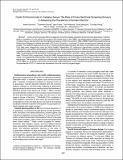| dc.contributor.author | Solomon, Nadia | |
| dc.contributor.author | Zeyhle, Eberhard | |
| dc.contributor.author | Carter, Jane | |
| dc.contributor.author | Wachira, John | |
| dc.contributor.author | Mengiste, Asrat | |
| dc.contributor.author | Romig, Thomas | |
| dc.contributor.author | Fields, Paul J. | |
| dc.contributor.author | Macpherson, Calum N. L. | |
| dc.date.accessioned | 2021-08-19T20:23:27Z | |
| dc.date.available | 2021-08-19T20:23:27Z | |
| dc.date.issued | 5/30/2017 | |
| dc.identifier.citation | Am. J. Trop. Med. Hyg., 97(2), 2017, pp. 587–595 doi:10.4269/ajtmh.16-0643 | en_US |
| dc.identifier.uri | http://repository.amref.org/handle/123456789/102 | |
| dc.description | Am. J. Trop. Med. Hyg., 97(2), 2017, pp. 587–595
doi:10.4269/ajtmh.16-0643
Copyright © 2017 by The American Society of Tropical Medicine and Hygiene | en_US |
| dc.description.abstract | Cystic echinococcosis (CE) is a neglected zoonotic disease caused by Echinococcus granulosus. Infection
leads to formation of cysts within the viscera of the human host. In the 1980s, the transhumant population of northwest
Turkana, Kenya, was found to have the highest prevalence of CE in the world. In 1983, AMREF Health Africa and the Kenya
Medical and Research Institute launched a CE Control Program in northwest Turkana, screening and treating the local
people. This epidemiological study of CE in Turkana analyses approximately 30 years of surveillance and surgical data.
Cyst data were categorized using the World Health Organization CE ultrasound classification system before being
analyzed for cyst, patient, and population characteristics, and surveillance data from 1985 are compared with more recent
surveillance data to assess changes in prevalence in the control region since the commencement of control activities. In
1985, the prevalence of CE among the Turkana was 5.6%. In 2010–2011 and 2011–2012, calculated CE prevalence rates
were 1.9% and 3.8%, respectively. Since the 1980s, the age distribution of people with CE in Turkana has shifted: initially,
cases of CE appeared predominantly within younger age groups, but recent data reveal a higher prevalence within older
age groups. The frequency of infection in females also significantly decreased. The reduction in CE prevalence from 5.6%
in the 1980s to 1.9–3.8% in 2010–2012 and the shift in age distribution of CE-infected individuals over time indicate that
the prevalence of CE in Turkana has decreased since the control program began. | en_US |
| dc.description.sponsorship | Amref Health Africa (formerly the African Medical and Research Foundation),
the Kenya Medical Research Institute (KEMRI), the Deutsche Forschungsgemeinschaft (DFG), and the Cystic Echinococcosis in SubSaharan Africa Research | en_US |
| dc.language.iso | en | en_US |
| dc.publisher | The American Society of Tropical Medicine and Hygiene | en_US |
| dc.subject | Cystic Echinococcosis | en_US |
| dc.subject | Cross-sectional Screening Surveys | en_US |
| dc.subject | Infection | en_US |
| dc.subject | Cyst | en_US |
| dc.subject | Turkana | en_US |
| dc.subject | Kenya | en_US |
| dc.title | Cystic Echinococcosis in Turkana, Kenya: The Role of Cross-Sectional Screening Surveys in Assessing the Prevalence of Human Infection | en_US |
| dc.type | Article, Journal | en_US |

